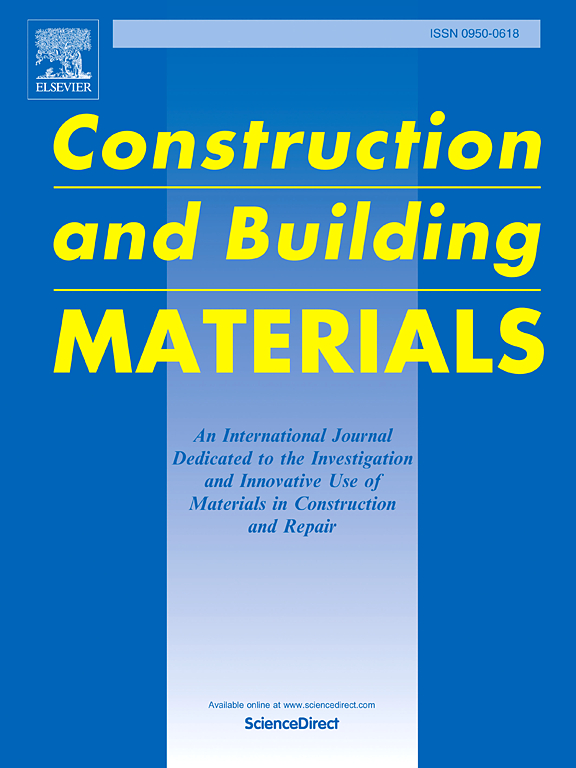Modulation of asbestos wettability: A mechanistic exploration of experimental and molecular modeling of surfactant types
IF 7.4
1区 工程技术
Q1 CONSTRUCTION & BUILDING TECHNOLOGY
引用次数: 0
Abstract
Surfactant type is a key parameter affecting the interaction of water molecules with surfactants and its mechanism for regulating the wetting properties of asbestos has not been fully elucidated. In this paper, a combination of experiments, quantum chemical calculations, and molecular dynamics simulations has been utilized to thoroughly analyze the wetting properties of different surfactants on asbestos. The experimental results indicated that the contact angle decreased significantly with increasing concentration at surfactant levels below 0.05 wt%, reaching 0.09 wt% where AES demonstrated the most effective wetting. Depth-of-field microscopic observations showed that surfactant treatment could significantly reduce the roughness of the asbestos surface, decrease the number of pores and cracks, and enhance the dust suppression effect. Quantum chemical calculations revealed that the AES molecule promotes electrostatic adsorption with asbestos and improves wetting properties due to the strong negative ESP of its oxyethylene and sulphonate groups. Molecular dynamics simulations provide additional insights into how different surfactant types affect the wettability of asbestos, indicating that electrostatic interactions are crucial in determining the adsorption of water molecules. The hydrophilic groups of AES are positioned nearer to the asbestos surface, enhancing the adsorption of water molecules onto it. Combining experimental and simulation findings, the wettability of the eight surfactants on asbestos was AES > SDBS > AEO3 > BS-12 > CAB-35 > AEO9 > DTAB > CTAB. This study affirmed the outstanding effect of AES as a potential surfactant for asbestos wetting and also furnished a theoretical foundation for exploring the mechanism of asbestos wetting.
石棉润湿性的调节:表面活性剂类型的实验和分子模型的机械探索
表面活性剂类型是影响水分子与表面活性剂相互作用的关键参数,其调节石棉润湿性能的机理尚未完全阐明。本文采用实验、量子化学计算和分子动力学模拟相结合的方法,全面分析了不同表面活性剂对石棉的润湿性能。实验结果表明,当表面活性剂浓度低于0.05 wt%时,接触角随表面活性剂浓度的增加而显著减小,达到0.09 wt%时,AES的润湿效果最好。景深显微镜观察表明,表面活性剂处理能显著降低石棉表面粗糙度,减少孔隙和裂纹数量,增强抑尘效果。量子化学计算表明,AES分子由于其氧乙烯基和磺酸基的强负电潜电作用,促进了与石棉的静电吸附,并改善了润湿性能。分子动力学模拟为了解不同表面活性剂类型如何影响石棉的润湿性提供了额外的见解,表明静电相互作用是决定水分子吸附的关键。AES的亲水基团位于更靠近石棉表面的位置,增强了水分子在其上的吸附。结合实验和仿真结果,八的润湿性对石棉表面活性剂AES祝辞 深发展祝辞 AEO3祝辞 BS-12 祝辞 CAB-35 祝辞 AEO9祝辞 DTAB祝辞 CTAB。本研究肯定了AES作为一种潜在的表面活性剂对石棉润湿效果的突出,也为探讨石棉润湿机理提供了理论基础。
本文章由计算机程序翻译,如有差异,请以英文原文为准。
求助全文
约1分钟内获得全文
求助全文
来源期刊

Construction and Building Materials
工程技术-材料科学:综合
CiteScore
13.80
自引率
21.60%
发文量
3632
审稿时长
82 days
期刊介绍:
Construction and Building Materials offers an international platform for sharing innovative and original research and development in the realm of construction and building materials, along with their practical applications in new projects and repair practices. The journal publishes a diverse array of pioneering research and application papers, detailing laboratory investigations and, to a limited extent, numerical analyses or reports on full-scale projects. Multi-part papers are discouraged.
Additionally, Construction and Building Materials features comprehensive case studies and insightful review articles that contribute to new insights in the field. Our focus is on papers related to construction materials, excluding those on structural engineering, geotechnics, and unbound highway layers. Covered materials and technologies encompass cement, concrete reinforcement, bricks and mortars, additives, corrosion technology, ceramics, timber, steel, polymers, glass fibers, recycled materials, bamboo, rammed earth, non-conventional building materials, bituminous materials, and applications in railway materials.
 求助内容:
求助内容: 应助结果提醒方式:
应助结果提醒方式:


